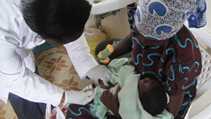Malaria Vaccine Trial: Behind the Scenes in Kenya

First results of the RTS,S/AS01 malaria vaccine trial are encouraging. They show that the candidate vaccine prevented about half of clinical and severe malaria cases in young children.
In 2008, CDC malaria expert Dr. Mary Hamel learned that the Malaria Vaccine Institute was looking for leading research institutions in Africa to conduct Phase III clinical trials of the world’s most advanced malaria candidate vaccine, RTS,S/AS01. Recognizing that CDC’s nearly 30 years of collaboration on malaria research with the Kenya Medical Research Institute (KEMRI) would uniquely qualify it for serving as vaccine trial site, she told herself: “We must apply.”
Says Dr. Hamel, “From the time I started working in western Kenya in 1995, I’ve heard the community asking when they would get a malaria vaccine. And I’ve seen too many children die from malaria. I was thrilled at the prospect that we could be part of a study testing a vaccine that might be able to save hundreds of thousands of children’s lives.”
Malaria killed an estimated 700,000 people around the world in 2010.Most of these deaths were in young African children. In western Kenya, where KEMRI/CDC is located, Anopheles mosquitoes transmit malaria year-round, and malaria is the leading killer of children and the most frequent cause of outpatient visits and hospital admissions.
2008 KEMRI/CDC was selected as one of the leading African research institutions and their Northern academic partners to conduct the trial, which is taking place at 11 sites in 7 African countries—Burkina Faso, Gabon, Ghana, Kenya, Malawi, Mozambique, and Tanzania—from 2009 through 2014.
KEMRI and CDC’s long collaboration began in 1979 when the CDC/KEMRI Kenya Research Station was established and began to conduct malaria research. Over the years, the partnership has expanded to include HIV, TB, and other diseases, and the Field Station changed its name to reflect its larger mission: the KEMRI/CDC Research and Public Health Collaboration. That close collaborative relationship proved invaluable during the vaccine trial.
- Page last reviewed: March 19, 2014
- Page last updated: March 19, 2014
- Content source:


 ShareCompartir
ShareCompartir